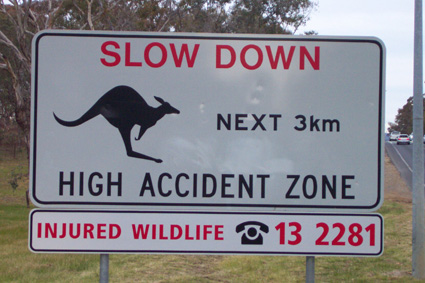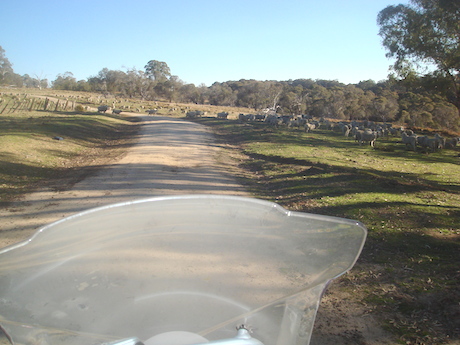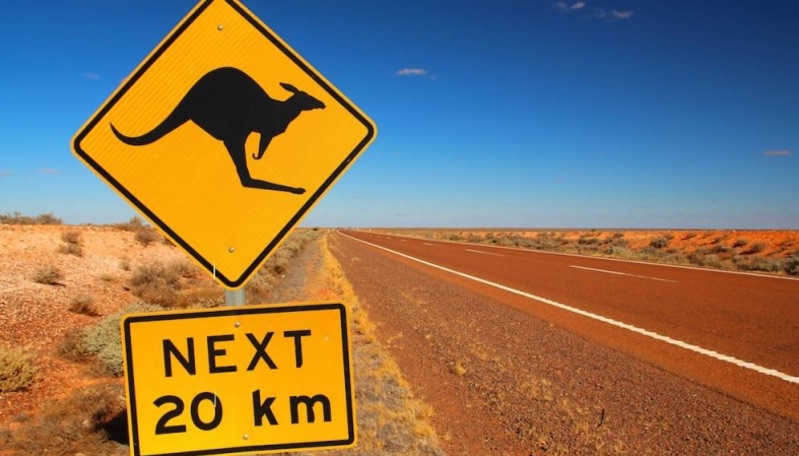In Australia, the kangaroo, wallaby and pademelon (yes, that’s right!) are the biggest enemy of riders accounting for 70% of all crashes with animals.
However, you’d be surprised what other animals are on the list, according to Suncorp insurance claims data.
Dogs are next with 7.7% of all motorcycle-versus-animal strikes, but it would have been worse years ago before fencing laws.
Anyone who was riding before these laws will remember fending off snarling dogs with their boot.
Suncorp Insurance CEO Anthony Day is a motorcycle rider who has had his fair share of close encounters with the animal kind.
“Often when riding – especially in the bush – I’ve had near misses with various animals,” says Anthony who rides a 2014 Indian Chief Vintage.

“When you’re on a bike, the experience of hitting a bird or mammal is not simply an uncomfortable and frightening experience, but can be life threatening.
“As CEO of one of the largest insurers in Australia, I know of too many motorcyclists who have had an animal collision.
“Fortunately, the overall numbers of animal collisions reported is relatively low.”
Statistics of types of animals
Suncorp animal claims from July 1, 2012, to November 30, 2016.
(633 claims in total, motorcycles 614, off-road bike 17, moped or scooter 2.)
|
Animals |
No of Claims |
%age |
|
Kangaroo |
380 |
60.03% |
|
Wallaby |
62 |
9.79% |
|
Dog |
49 |
7.74% |
|
Emu |
22 |
3.48% |
|
Cow |
21 |
3.32% |
|
Bird (non-specific) |
11 |
1.74% |
|
Wombat |
10 |
1.58% |
|
Sheep |
10 |
1.58% |
|
Animal (non-specific) |
10 |
1.58% |
|
Cat |
8 |
1.26% |
|
Fox |
7 |
1.11% |
|
Bush Turkey |
6 |
0.95% |
|
Deer |
5 |
0.79% |
|
Cockatoo |
4 |
0.63% |
|
Horse |
3 |
0.47% |
|
Hare |
3 |
0.47% |
|
Goat |
3 |
0.47% |
|
Eagle |
3 |
0.47% |
|
Owl |
3 |
0.47% |
|
Ducks |
2 |
0.32% |
|
Wild Boar |
2 |
0.32% |
|
Goanna |
2 |
0.32% |
|
Snake |
1 |
0.16% |
|
Chicken |
1 |
0.16% |
|
Bandicoot |
1 |
0.16% |
|
Pademelon |
1 |
0.16% |
|
Possum |
1 |
0.16% |
|
Echidna |
1 |
0.16% |
|
Pig |
1 |
0.16% |
|
Total |
633 |
100.00% |
Animal strikes by state/territory
|
Moped or Scooter |
Motorcycle |
Off-Road Bike |
Total |
%age | ||||||
|
Australian Capital Territory |
|
14 |
|
14 |
2.21% |
|||||
|
New South Wales |
|
241 |
5 |
246 |
38.86% |
|||||
|
Northern Territory |
|
8 |
|
8 |
1.26% |
|||||
|
Queensland |
1 |
163 |
3 |
167 |
26.38% |
|||||
|
South Australia |
|
45 |
1 |
46 |
7.27% |
|||||
|
Tasmania |
|
14 |
1 |
15 |
2.37% |
|||||
|
Victoria |
|
86 |
6 |
92 |
14.53% |
|||||
|
Western Australia |
1 |
43 |
1 |
45 |
7.11% |
|||||
|
Grand Total |
2 |
614 |
17 |
633 |
|
|||||
“Collisions can happen at any time, but riding at night brings additional risks,” Anthony warns.
“I try to avoid riding at night but when I do, I am grateful the Indian has powerful driving lights. If your bike doesn’t have good lights, it’s a wise investment.
“On every ride, I wear protective gear and like to practise my braking and swerving techniques. Practice is the only way to ensure you have these skills when you need them.
“I’m conscious of the fact that if I do collide with an animal, it could be someone’s pet or carrying young. If you find yourself in that situation, it’s important to check its injuries and do what you can to help.”
MBW TIPS ON AVOIDING ANIMAL STRIKES

Obviously the most important is to avoid riding between dusk and early morning. This is when animals tend to roam around for food and when their brown hides are more difficult to see. But we’ve also known riders to hit animals in the middle of the day, so there is no time when you are totally safe. You always need to be on alert.
SCAN
You should always be scanning the sides of the road for animals – dead or alive. Early detection can help prevent a collision by giving you time to slow down and work out an exit strategy. Don’t just use your eyes … use your nose, too. If you smell roadkill, it means there are more animals about.
ROAD POSITION
If there is dense bush on one side of the road, ride close to the edge of the lane as far away from the bush as possible. In remote country regions, you can even ride on the opposite side of the road for a short while to give you as much distance as possible from animals lurking in roadside bushes and trees. The common country tip is to ride in the centre of the road to give yourself the maximum buffer zone.
SLOW DOWN
Slow down when the danger increases, such as if dense bush is close to the road, or when entering a national park or when riding through unfenced farming land. If you do encounter an animal on the road, the only way to avoid hitting it is to slow down. Hitting or glancing even a small animal at speed can send you flying. Wash off as much speed as you can and hold your course. Wait until the last second to decide on avoidance action.
BEHAVIOUR

Some animals behave more predictably than others. Usually packs of animals will head in the same direction, so you simply aim for the rear of the pack. However, we’ve aimed for the rear of a herd of sheep only to have them do a complete u-turn (ewe-turn?) and surround the bike. Luckily I was able to slow down and just bounce off a couple.
WHISTLES
We’ve tried one of those devices that you place on the front of your bike that creates a high-pitched whistle which apparently only animals can hear. The noise is supposed to disperse the animals. However, we find it doesn’t work on kangaroos for which it is mainly intended, but it does work on birds.
BIRDS
Don’t underrate the effect of large birds to cause havoc for riders. I’ve had my hand knocked off the handlebars when I hit a crow at highway speeds. I’d hate to hit one of those big eagles! If you see birds on the road, they are probably picking at roadkill and are too preoccupied to notice your approaching bike. Don’t just hope that they will disperse. Give them a warning honk in plenty of time so they will scatter.
NOISES
A Goldwing rider claims the loud stereo on his bike works to disperse roos and other wildlife. In fact, any loud noise will work. Sudden noises are better than the constant whine or rumble of your approaching bike. Gun the engine every now and then, or blow the horn especially as you crest a hill or round a blind corner. It alerts the animals and hopefully they will head for the bushes.
LIVESTOCK

Most livestock allowed to roam beside the roads are accustomed to the noise of traffic and won’t be alarmed. However, young animals and horses can be quite skittish, so it is best to slow down and even pull in the clutch to quieten your exhaust noise as you roll by.
ROOS
We’ve encountered just about every type of wildlife and livestock possible in Australia and many in the US, but the most unpredictable would have to be the kangaroo. It stops, looks at you, then hops away, then turns around and hops straight back in your path. Sometimes they just dart out of the bushes and run straight into you. A friend had his front wheel taken out from under him by a small rock wallaby. He didn’t even see it; next thing he was sliding along the ground. Roos are in plague proportions and are a menace on our roads. Sorry to all animal lovers, but we support culling their population. Meanwhile, the best course of action if you see a kangaroo at the side of the road and you are travelling too fast to be able to stop is not to blow the horn. That will only startle it into an erratic response. Most times a roo on the side of the road will be too busy grazing on the “green pick” to be startled by the gradually increasing rumble of your approaching bike.
VERDICT
There is no simple guaranteed answer to prevent you from becoming roadkill and protecting our wildlife, but if you use some of these tips, it you should increase your chances of a safe ride.


